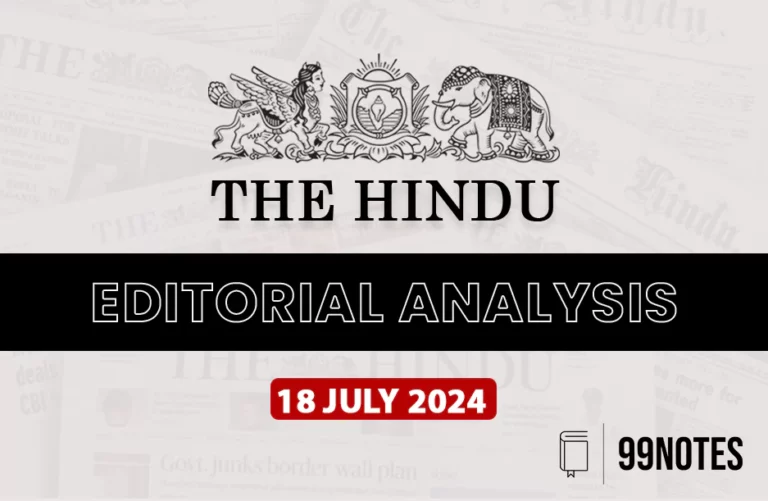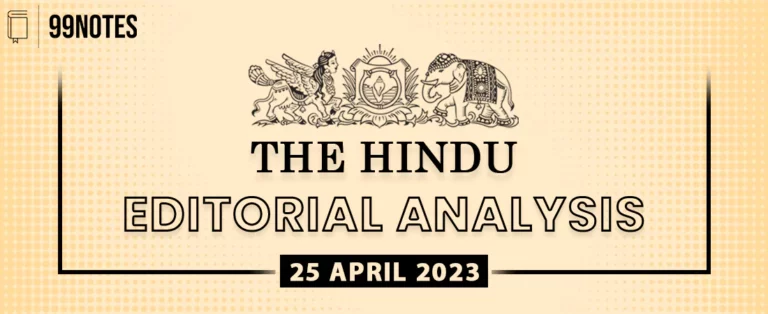22 November 2023 : The Hindu Editorial Notes PDF
The Hindu Editorial
22-November-2023
1. Recognising the impact of climate change on health.
Topic: GS3 – climate change
Introduction:
As India prepares for the 28th Conference of the Parties to the United Nations Framework Convention on Climate Change (COP28), there is a critical need to assess the impact of climate change on the country’s health. India’s vulnerable health systems exacerbate the population’s susceptibility to climate-related health risks.
Direct Health Impacts:
Climate change directly contributes to increased sickness and mortality rates. With the alarming rise in global temperatures, parts of India face the threat of becoming uninhabitable, a stark deviation from the Paris Agreement’s goal of limiting temperature increases to 1.5°C.
The year 2023 witnessed record-breaking temperatures and heatwaves, foreshadowing an intensification of climate emergencies such as extreme heat, cyclones, and floods.
Double Burden of Morbidity:
India grapples with a dual health burden from both communicable and non-communicable diseases, further compounded by climate change. The changing climate facilitates the growth and altered seasonality of disease vectors, potentially introducing new health risks.
Non-communicable diseases, often overlooked, face exacerbation due to factors like increased air pollution, heat-induced kidney injuries, and mental health issues heightened by climate-induced stress.
Urbanization Challenges:
India’s rapid and unplanned urbanization exacerbates the impact of climate change, particularly in urban areas experiencing the urban heat island effect. Lack of green spaces, air pollution, and stress from urban living compound health challenges. The weak urban primary health system is strained by climate-related health issues.
Mitigation Strategies:
Addressing the health impact of climate change requires comprehensive mitigation efforts at the global, regional, and local levels. A crucial starting point is understanding the direct and indirect pathways through which climate change affects health.
Socio-economic conditions play a significant role, necessitating social support systems and adapted health services. However, more significant benefits arise from upstream interventions, including improved urban planning, increased green cover, water conservation, and public health initiatives.
Call to Action:
Efforts to combat climate change and its health implications must involve coordinated action at all levels—global, regional, and local. Researchers play a vital role in providing policy options, and governments need to commit to implementing evidence-based strategies.
Meaningful change requires the convergence of problem recognition, policy formulation, and political decision-making.
Conclusion:
Addressing climate change’s impact on health in India requires a multifaceted approach that integrates scientific understanding, policy implementation, and political commitment. As COP28 approaches, there is an urgent need for coordinated efforts to mitigate the health risks posed by climate change in the country.
Question: Discuss the interplay between climate change and public health in India. Suggest policy measures to mitigate the health risks associated with climate change, emphasizing the role of global, regional, and local interventions.
2. All nations must strive for net zero carbon emissions
Topic: GS3 – climate change
Context:
- The report cleverly titled “Broken Record” suggests that warnings on rising greenhouse gas emissions (GHG) are not only being ignored but that new emission ceilings are being breached.
Progress Since Paris Agreement (PA):
- Tardy Progress: The report highlights that progress since the Paris Agreement (2015) has been slow in curbing emissions.
- Temperature Goals: The PA aimed to limit temperature rise to below 2°C, with efforts to stay below 1.5° However, the report indicates an overshoot of 2.5°C-2.9°C by the end of the century, even considering countries’ commitments to reduce reliance on fossil fuels.
Emission Reduction Targets:
- 2030 Targets: To limit temperature rise, emissions must be cut by 28% by 2030 for 2°C and by 42% for 1.5°C.
- Credibility of “Net Zero” Pledges: The report questions the credibility of countries’ “net-zero” pledges, and even in optimistic scenarios, the likelihood of achieving emissions below 1.5°C is only 14%.
Paris Agreement Impact:
- Reduction in Projected Emissions: The PA has had an impact, reducing the projected increase in emissions from 16% to 3% by 2030.
- Continuous Reduction Needed: To stay below 1.5°C, annual emissions must decrease by 8.7% until 2030.
Current Emission Status:
- Post-Pandemic Emissions: The report notes a 1.2% increase in global emissions in 2022 compared to 2021, with the world nearly returning to pre-pandemic emission levels.
- Consequences: The consequences of delayed action are evident, with numerous days surpassing 1.5°C above pre-industrial levels and record-breaking temperatures in September.
Solutions and Urgency:
- Responsibility of Rich Nations: The report emphasizes that wealthier and historically responsible nations must commit to greater and faster emission reductions.
- Limited Time: With little time remaining, urgent global action is necessary to address climate change effectively.
In summary, the “Broken Record” report underscores the urgency of more substantial and quicker efforts by nations, especially those historically responsible, to meet emission reduction targets and combat the escalating consequences of climate change.
3. States need to implement labour rights uniformly and not rely on protectionism.
Topic: GS3 – labour rights
Context:
The Punjab and Haryana High Court’s decision to quash the Haryana State Employment of Local Candidates Act, 2020, which mandated 75% reservation for State domiciles in private sector jobs below ₹30,000/month, carries significant implications.
Court’s Decision and Constitutional Violations:
The court, deeming the legislation beyond the State’s authority, asserted that it violated constitutional principles, specifically Article 14 (equality) and Article 19 (freedom). The Act’s imposition of a 75% reservation for “locals” was viewed as encroaching upon the rights of citizens nationwide, potentially leading to a proliferation of similar enactments and the creation of divisive “artificial walls” across India.
Broader Impact and Concerns:
Similar legislation in other states, such as Andhra Pradesh and Jharkhand, faces constitutional scrutiny. The economic repercussions of such laws are significant, potentially impeding job mobility and impacting the nation’s overall economic landscape.
Addressing Worker Rights and Exploitative Practices:
Acknowledging the existence of exploitative practices by certain private employers in the migrant labor market, the ruling advocates for a comprehensive approach. Instead of resorting to protectionist measures, it emphasizes the necessity of ensuring basic labor rights for migrant workers, thereby creating a level playing field for all workers.
Policy Recommendations and Anti-Exploitation Measures:
The court suggests a policy focus on establishing fairness in labor practices, emphasizing the importance of anti-exploitation measures over protectionism. Ensuring that migrant workers enjoy legally mandated labor rights becomes a central recommendation to foster fair competition and discourage market segmentation.
Conclusion:
In essence, the ruling underscores the imperative for equitable labor practices and measures against exploitation, highlighting the need for policies that prioritize workers’ rights over protectionist tendencies.
Question: Examine the constitutional implications of the Punjab and Haryana High Court’s decision to invalidate the Haryana State Employment of Local Candidates Act, 2020. Discuss the potential consequences on national unity and propose alternative measures for addressing regional job concerns while ensuring equitable worker rights.
4. India, Japan converge in Southeast Asia.
Topic: GS2 – International relations
Philippines’ Shift in Infrastructure Focus:
- Chinese Projects Dropped: The Philippines abandons Chinese-led infrastructure projects due to sustainability and geopolitical concerns.
- New Focus on Japan and India: Manila redirects attention to Japan and India as alternative sources for development and security assistance.
Philippines’ Strategic Vision:
- Sovereignty Concerns: Under President Ferdinand Marcos Jr., the Philippines prioritizes sovereignty in the West Philippine Sea against China’s revisionist interests.
- Multifaceted Cooperation: Aims to deepen economic and security partnerships with like-minded partners beyond traditional alliances.
India-Philippines Bilateral Ties:
- Advancements in Relations: Growing bilateral relationship, highlighted by visits and agreements between the Philippines and India.
- Strategic Cooperation: Memorandum of Understanding (MoU) between Philippine and Indian Coast Guards for improved interoperability and intelligence sharing.
Regional Significance:
- Hedging Strategies: Southeast Asian countries, including the Philippines, seek robust ties with regional powers to reduce susceptibility to China’s influence.
- Top Choices for Strategic Partners: Japan and India emerge as the top choices for alternative Indo-Pacific strategic partners, as per the State of Southeast Asian Survey of 2023.
India-Japan Partnership:
- Shared Vision: India and Japan’s Special Strategic and Global Partnership is defined by robust security ties, regular military exercises, and multilateral frameworks.
- Third-Country Cooperation: Collaboration in establishing growth corridors like the Asia Africa Growth Corridor (AAGC) and exploring trilateral partnerships with other Asian nations.
Opportunities for India in Southeast Asia:
- Alternative Developmental Model: India should consider extending its third-country developmental model with Japan into the sub-region of the greater Indo-Pacific.
- Amidst U.S.-China Power Competition: Resident countries seeking alternative sources of development and security create opportunities for India’s deeper engagement.
Question: Evaluate the significance of the Southeast Nations’ collaboration with Japan and India as alternative sources of development and security, considering the broader implications for regional partnerships and the evolving Indo-Pacific geopolitical dynamics.
For Enquiry

22 November 2023 : The Hindu Editorial Notes PDF

Union Council of Ministers

The Governor

President

The Prime Minister

The Vice-President

21 Nov 2023 : Daily Answer Writing

21 Nov 2023 : Daily Quiz

21 Nov 2023 : Indian Express

21 Nov 2023 : PIB
November 2023 The Hindu 22 November 2023 : The Hindu Editorial Notes PDF The Hindu Editorial
21-November-2023
1. Making sense of the employment challenge
Topic: GS3 – Indian…
Executive Union Council of Ministers Introduction :
In a Parliamentary System, the Council of Ministers (CoM) headed by the Prime Minister…
Executive The Governor Introduction :
Article 153 of the Indian Constitution states that “there shall be a Governor for each…
Executive President The Parliamentary system of government is characterised by the presence of dual executives. The Union…
Executive The Prime Minister Article 74 of the Constitution provides that “there shall be a Council of Ministers with the Prime Minister…
Executive The Vice-President Article 63 of the Indian Constitution provides that there shall be a Vice-President of India. The Vice…
mains answer writing 21 Nov 2023 : Daily Answer Writing Mains Answer Writing
21-November-2023
Q1) From the perspective of a coherent political history of South…
Daily Quiz 21 Nov 2023 : Daily Quiz 21 Nov 2023 : Daily Quiz…
Indian Express 21 Nov 2023 : Indian Express Indian Express
21-November-2023
1) Reining in the governor
Context:
The article focuses on the recent…
November 2023 PIB 21 Nov 2023 : PIB PRESS INFORMATION BUREAU
21-November -2023
1. Union Health Ministry solicits comments from general…



